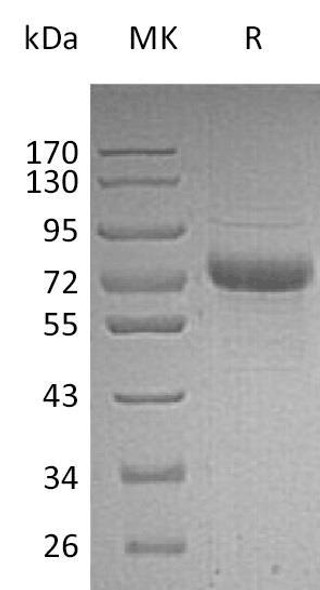Recombinant Human Vitronectin/V75/VTN Protein (RPCB1404)
- SKU:
- RPCB1404
- Size:
- 20µg
- Tag:
- C-His
- Reactivity:
- Human
- Expression Host:
- HEK293 cells
Description
| Product Name: | Recombinant Human Vitronectin/V75/VTN Protein |
| SKU: | RPCB1404 |
| Size: | 20µg |
| Tag: | C-His |
| Reactivity: | Human |
| Expression Host: | HEK293 cells |
| Protein Description: | High quality, high purity and low endotoxin recombinant Recombinant Human Vitronectin/V75/VTN Protein , tested reactivity in HEK293 cells and has been validated in SDS-PAGE.100% guaranteed. |
| Endotoxin: | <1EU/μg |
| Purity: | > 95% by SDS-PAGE. |
| Formulation: | Lyophilized from a 0.22 μm filtered solution of PBS, pH 7.4. |
| Gene ID: | 7448 |
Vitronectin, also known as VTN, is a member of the pexin family. It is an abundant glycoprotein found in serum the extracellular matrix and promotes cell adhesion and spreading. Vitronectin is a secreted protein and exists in either a single chain form or a cleaved, two chain form held together by a disulfide bond. Vitronectin is a plasma glycoprotein implicated as a regulator of diverse physiological process, including blood coagulation, fibrinolysis, pericellular proteolysis, complement dependent immune responses, and cell attachment and spreading. Because of its ability to bind platelet glycoproteins and mediate platelet adhesion and aggregation at sites of vascular injury, vitronectin has become an important mediator in the pathogenesis of coronary atherosclerosis. As a multifunctional protein with a multiple binding domain, Vitronectin interacts with a variety of plasma and cell proteins. Vitronectin binds multiple ligands, including the soluble vitronectin receptor. It may be an independent predictor of adverse cardiovascular outcomes following acute stenting. Accordingly, Vitronectin is suggested to be involved in hemostasis, cell migration, as well as tumor malignancy.
| Storage: | Store at -20℃.Store the lyophilized protein at -20℃ to -80 ℃ up to 1 year from the date of receipt.After reconstitution, the protein solution is stable at -20℃ for 3 months, at 2-8℃ for up to 1 week. |
| Reconstitution: | Centrifuge the vial before opening. Reconstitute to a concentration of 0.1-0.5 mg/mL in sterile distilled water. Avoid vortex or vigorously pipetting the protein. For long term storage, it is recommended to add a carrier protein or stablizer (e.g. 0.1% BSA, 5% HSA, 10% FBS or 5% Trehalose), and aliquot the reconstituted protein solution to minimize free-thaw cycles. |
| Swiss-Prot: | P04004 |








